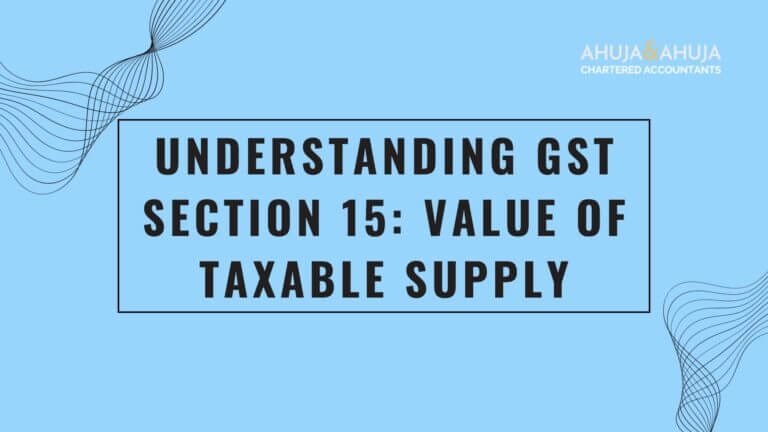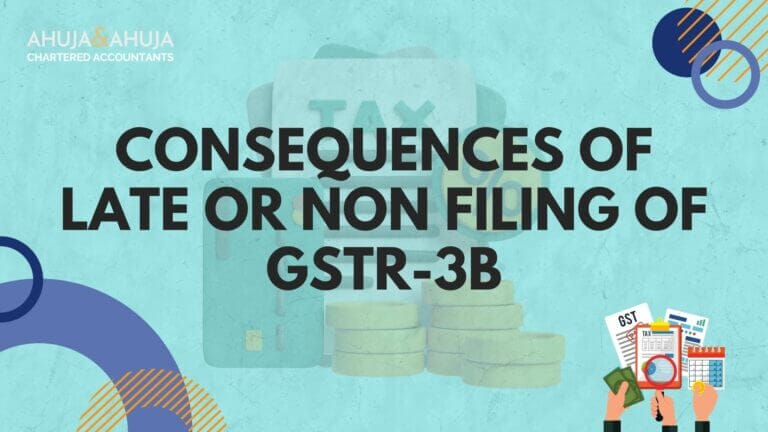GST Procedure in case of Death of Proprietor
When a sole proprietor passes away, the business and its GST obligations don’t simply vanish. Instead, the law draws a clear roadmap for legal heirs—whether they wish to close the business or carry it forward. This article, presented in three parts, unpacks the GST procedures, compliance steps, and practical nuances that legal heirs must navigate in both scenarios.
Understanding the Landscape: Why GST Succession Matters
The death of a proprietor is not just a personal loss—it’s a legal event that instantly alters the status of the business. Unlike companies or partnerships, a proprietorship is inseparable from its owner. Legally, the business ceases to exist the moment the proprietor passes away. Yet, GST law recognizes the practical need for continuity or closure, and provides a structured process for both.
Why is this so important? Because GST compliance doesn’t pause for grief. Unattended, it can snowball into penalties, interest, and even legal disputes. Succession planning, though often overlooked, is vital for every proprietor and their family. For professional guidance on GST, consulting GST consultancy services can be very helpful.
What Happens to a Proprietorship After Death?
1. Legal Extinguishment
A proprietorship is not a separate legal entity. Upon the proprietor’s death, the business is extinguished. However, GST law steps in to allow legal heirs to either discontinue or continue the business, provided they follow the prescribed procedures.
2. GST Law’s Role in Succession
GST law, through Sections 22, 29, 85, and 93 of the CGST Act, lays out the compliance path for both discontinuance and continuance. The law distinguishes between:
- Discontinuance: The business is wound up, GST registration is cancelled, and all dues are settled.
- Continuance: The business is transferred as a going concern to legal heirs, who must obtain new registration and transfer assets, liabilities, and ITC.
3. Immediate GST Compliance Obligations
Legal heirs must:
- Inform the GST authorities of the proprietor’s death.
- Decide whether to discontinue or continue the business.
- Initiate the appropriate GST procedures within statutory timelines (typically 30 days for cancellation or new registration). Filing all pending returns can be managed efficiently through GST return filing services.
Scenario 1: Discontinuance of Business
Let’s first explore the path when legal heirs decide to close the business.
A. GSTIN and Authorisation
Who Can Apply for GST Cancellation?
Only legal heirs can apply for cancellation of the deceased’s GST registration. But there’s a catch: they must first be recognized as Authorised Signatories for the GSTIN.
How Do Legal Heirs Become Authorised Signatories?
- Legal heirs cannot amend the registration online themselves.
- They must approach the jurisdictional GST officer with a formal request and supporting documents.
- The officer, after verifying the documents, adds the legal heir as an Authorised Signatory.
Why Officer’s Intervention?
Section 28 and Rule 19 of the CGST Rules allow only the registered person to amend registration. Since the proprietor is deceased, only the officer can process this request.
What Documents Are Needed?
- Death certificate of the proprietor
- Proof of legal heirship (succession certificate, will, or legal heir certificate)
- Identity proofs of both deceased and legal heir (Aadhaar, PAN, Passport)
- NOC from other legal heirs (if multiple heirs exist), typically in affidavit format
B. GST Returns, Cancellation, and Payment on Stock
Returns to Be Filed
All pending GST returns (GSTR-1, GSTR-3B, etc.) up to the date of death must be filed. This ensures no liability is left unreported.
Checking Pending Liabilities
Legal heirs can log into the GST portal to check for any outstanding returns or tax dues.
Timeline for Cancellation
Application for cancellation must be filed within 30 days of the proprietor’s death, citing “Death of Proprietor” as the reason.
Tax on Closing Stock and Capital Goods
Section 29(5) requires payment of GST on:
- The higher of input tax credit (ITC) on stock/capital goods or output tax on such goods, as of the day before cancellation.
- For capital goods, ITC is reduced by prescribed percentages or tax on transaction value, whichever is higher.
Payment Mechanism
GST on stock is paid via the electronic credit ledger (if ITC is available) or cash ledger.
Treatment of ITC Balance
Any unutilized ITC in the electronic credit ledger lapses upon cancellation.
GSTR-10 (Final Return)
This must be filed within three months from the date of cancellation order or the actual date of cancellation, whichever is later.
C. Legal Heirs’ Liability and Estate Considerations
Extent of Liability
Section 93(1)(b) limits the legal heirs’ liability to the value of the estate inherited. They are not personally liable beyond the estate’s capacity.
Posthumous GST Demands
If GST demands arise after the proprietor’s death, legal heirs must settle them from the estate, up to its value.
[SIDEBAR: Checklist for GST Compliance by Legal Heirs (Discontinuance)]
- Obtain death certificate and legal heir proof
- Approach GST officer to become Authorised Signatory
- File all pending GST returns
- Check and clear outstanding liabilities
- Apply for GSTIN cancellation within 30 days
- Calculate and pay GST on closing stock/capital goods
- File GSTR-10 (Final Return) within 3 months
- Retain all documents for future reference
For professional assistance with GST procedures, you may check detailed GST registration services in India offered by experts.
Scenario 2: Continuance of Business by Legal Heirs
When legal heirs choose to continue the business, GST law offers a structured pathway to ensure a smooth transition. This scenario is more involved than discontinuance, as it requires not just closure of the old GSTIN but also the seamless transfer of assets, liabilities, and compliance responsibilities.
A. Registration & Succession
Obtaining New GST Registration
Legal heirs must apply for a fresh GST registration in their own name (using their own PAN, as GST registration is PAN-based). The reason for registration should be cited as “Death of Proprietor,” and the effective date should match the date of the proprietor’s death.
Why Not Use the Deceased’s PAN?
GST registration is intrinsically linked to the PAN of the registered person. Since the legal heir is a different individual, a new registration under their PAN is mandatory.
Adding Legal Heirs as Authorised Signatories
Before winding up the old GSTIN, legal heirs must be added as Authorised Signatories. This, again, requires approaching the jurisdictional GST officer with:
- Death certificate
- Proof of legal heirship
- Identity documents
- NOC from other heirs (if applicable)
Banking Considerations
The current account linked to the deceased’s GSTIN should be closed. A new current account, mapped to the new GST registration, must be opened for all future business transactions.
B. Formal Transfer of Business and ITC
Legal Transfer of Business
The business, as a going concern, is transferred to the legal heir. This transfer is exempt from GST, provided all assets and liabilities are taken over.
Transferring Unutilised ITC (Form ITC-02)
- The legal heir (as transferee) must file Form ITC-02 on the GST portal to transfer any unutilised input tax credit from the deceased’s GSTIN to the new registration.
- A certificate from a practising Chartered Accountant or Cost Accountant is required, certifying that the transfer includes all liabilities.
- The transferee must accept the ITC-02 details on the portal, after which the credit is transferred.
If you need expert assistance with this, GST audit services can provide necessary support.
Accounting for Transferred Stock and Capital Goods
All stock and capital goods transferred must be properly recorded in the books of the new entity. This ensures transparency and compliance during audits.
Is GST Payable on Stock and Capital Goods?
No GST is payable on the transfer of stock and capital goods when the business is continued as a going concern by the legal heir. This is a key exemption under GST law.
C. Cancellations and Returns
Cancelling the Old GSTIN
Once the new registration is in place and ITC is transferred, the legal heir must apply for cancellation of the deceased’s GSTIN within 30 days of death.
Filing GSTR-10 (Final Return)
A final return (GSTR-10) must be filed for the old GSTIN within three months from the date of cancellation order or the actual date of cancellation, whichever is later.
What if ITC is Not Transferred?
If the ITC in the deceased’s electronic credit ledger is not transferred via ITC-02, it will lapse upon cancellation of the old GSTIN.
D. Liability in Case of Continuance
Pre- and Post-Death Liabilities
- For the period before the proprietor’s death, both the deceased’s estate and the legal heir (as successor) are jointly and severally liable for all GST dues, interest, and penalties (Section 85(1), Section 93(1)(a)).
- For the period after succession, the legal heir is fully liable for all GST obligations.
Joint and Several Liability Explained
This means the GST department can recover dues from either the estate of the deceased or the legal heir, or both, without limitation to the value of the estate.
Limitation of Liability: Discontinuance vs. Continuance
- Discontinuance: Liability is limited to the value of the estate inherited.
- Continuance: Liability is unlimited; the legal heir is fully responsible for all dues.
E. Practical and Operational FAQs
Can Business Transactions Continue During Transition?
Ideally, no new transactions (sales or purchases) should be initiated in the interim period between application and grant of new GST registration. However, transactions already initiated (e.g., pending deliveries or payments) can be completed.
Handling Ongoing Contracts, Invoices, and Payments
- Inform all customers, vendors, and banks about the change in business ownership and GSTIN.
- Update contracts and invoices to reflect the new GSTIN as soon as it is allotted.
- Ensure that payments received or made during the transition are properly accounted for.
Communicating with Stakeholders
A formal communication (letter or email) should be sent to all stakeholders, including customers, vendors, and banks, notifying them of the change in GST registration and business ownership.
Sector-Specific Considerations
Certain sectors, like textiles or job work, may have unique compliance requirements or pending RCM (Reverse Charge Mechanism) issues. Legal heirs should consult a GST expert for sector-specific guidance.
[SIDEBAR: Sample Template – NOC Among
- Q: Can I use the deceased’s PAN for new GST registration?
A: No, you must use your own PAN. - Q: Is GST payable on stock when business is continued?
A: No, if transferred as a going concern. - Q: What if there are multiple legal heirs?
A: A NOC from all heirs is required for one to act as Authorised Signatory.
Special Cases and Related Scenarios
Partnership Firms: What Changes on a Partner’s Death?
While GST law provides a clear succession path for proprietorships, partnership firms operate differently. If a partner dies and the partnership agreement doesn’t specify otherwise, the firm may dissolve—especially if only two partners existed. In such cases, the GST registration must be cancelled within 30 days, and all closure procedures (returns, payment on stock, GSTR-10) apply. Importantly, legal representatives of a deceased partner cannot simply step into the partnership; the law does not permit automatic succession in partnerships. Even if the partnership deed tries to allow it, the Supreme Court has held such provisions void.
For detailed information on partnership concerns, see the Business Setup Services offered by Ahuja & Ahuja.
Legal Representatives’ Rights and Limitations
Legal heirs or representatives can only act within the boundaries of the law and the estate. For partnerships, their rights are limited to settling the deceased’s share in the firm, not continuing the business as partners. For proprietorships, their rights and obligations are as outlined in the previous sections.
Consequences of Delay or Default
Missing GST compliance deadlines—whether for cancellation, return filing, or payment—can trigger late fees, interest, and penalties. The GST portal may also restrict further actions, and unresolved liabilities can lead to legal notices or even prosecution. If legal heirs ignore GST notices or fail to respond, the department can recover dues from the estate, and in some cases, initiate proceedings against the heirs themselves. For assistance with such situations, GST litigation services can be invaluable.
Notifications, Circulars, and Further Guidance
The GST Council and CBIC periodically issue clarifications and circulars on succession and transfer of business. Legal heirs should check the latest updates on the CBIC website or consult a GST professional for recent changes.
Professional Assistance: When to Seek Help
Given the legal and procedural complexity, engaging a Chartered Accountant or GST practitioner is highly recommended. They can help with:
- Drafting and submitting applications
- Preparing and verifying documentation
- Calculating tax on stock and ITC transfer
- Responding to GST notices and queries
- Navigating succession disputes
Responding to GST Notices Post-Death
If a GST demand or notice arrives after the proprietor’s death, legal heirs should respond promptly, providing proof of death and succession. If the business was discontinued, liability is limited to the estate. If continued, the legal heir is fully liable for all dues.
Documentation and Dispute Handling
Accepted Proofs for Legal Heirship
- Death certificate (mandatory)
- Succession certificate, legal heir certificate, or registered will
- Identity proofs (Aadhaar, PAN, Passport) of both deceased and heir
- NOC from other heirs (if multiple claimants)
Managing Multiple Heirs or Disputes
If more than one legal heir exists, a No Objection Certificate (NOC) from all other heirs is required for one to act as Authorised Signatory. In case of disputes, GST authorities may require a succession certificate or court order before proceeding.
User Experience and Troubleshooting
Common Mistakes by Legal Heirs
- Delaying GST cancellation or new registration
- Failing to file all pending returns before cancellation
- Overlooking the need for NOC among multiple heirs
- Not transferring ITC before cancelling the old GSTIN
- Ignoring GST notices or deadlines
FAQs, Helpdesks, and Support
The GSTN portal offers FAQs and a helpdesk (GST Helpdesk) for procedural queries. For complex cases, professional advice is invaluable.
Timeline Expectations
- Becoming Authorised Signatory: 1–2 weeks (subject to officer’s response)
- GSTIN cancellation: Within 30 days of death
- New registration: Usually processed within 7–10 days
- ITC transfer (ITC-02): Can be completed online once new GSTIN is active
- GSTR-10 (Final Return): Within 3 months of cancellation order
Appeal Mechanisms
If dissatisfied with a GST officer’s decision (e.g., rejection of application, dispute over liability), legal heirs can file an appeal under Section 107 of the CGST Act within three months of the order. For detailed processes, refer to appeal procedure for cancellation of GST registration.
Key Takeaways and Best Practices
- Discontinuance: Legal heirs’ liability is limited to the estate; ensure all returns are filed, dues paid, and GSTR-10 submitted.
- Continuance: Legal heirs must obtain new GST registration, transfer ITC, and are fully liable for all GST dues—past and future.
- Documentation: Keep all proofs, certificates, and NOCs ready; clear communication with authorities and stakeholders is crucial.
- Professional Guidance: Don’t hesitate to consult a CA or GST expert, especially in cases of disputes or complex transitions.
- Timeliness: Adhering to statutory timelines prevents penalties and legal complications.
Risk Mitigation for Legal Heirs
- Start GST formalities as soon as possible after the proprietor’s death.
- Maintain transparent records and communication with all stakeholders.
- Use checklists and templates to avoid missing steps.
- Seek professional help for succession disputes or technical GST issues.
Final Word
The GST law, while strict, is designed to provide a fair and structured process for business succession or closure after the death of a proprietor. With timely action, proper documentation, and professional support, legal heirs can navigate this transition smoothly—protecting both the family’s interests and the business’s legacy.
[SIDEBAR: GST Compliance Checklist for Legal Heirs]
- [ ] Obtain death certificate and legal heir proof
- [ ] Approach GST officer for Authorised Signatory status
- [ ] File all pending GST returns
- [ ] Check and clear outstanding liabilities
- [ ] Apply for GSTIN cancellation (or new registration) within 30 days
- [ ] Transfer ITC (if continuing business)
- [ ] File GSTR-10 (Final Return)
- [ ] Communicate changes to all stakeholders
For further reading, consult the latest GST notifications or reach out to a qualified GST practitioner.
Disclaimer
The materials provided herein are solely for educational and informational purposes. No attorney/professional-client relationship is created when you access or use the site or the materials. The information presented on this site does not constitute legal or professional advice and should not be relied upon for such purposes or used as a substitute for professional or legal advice.







